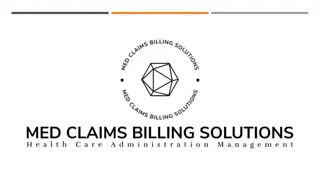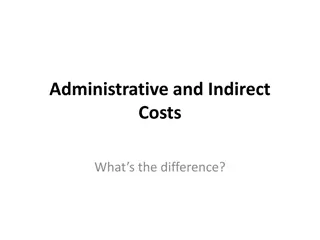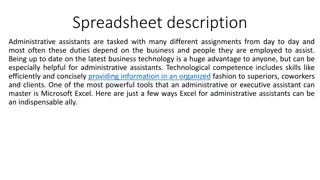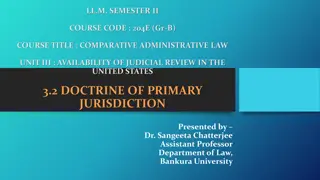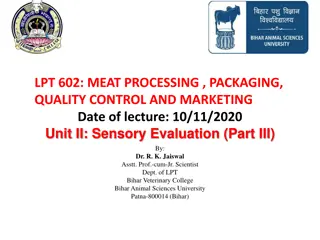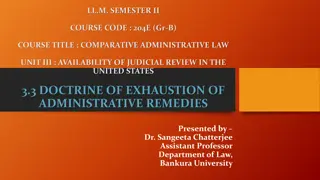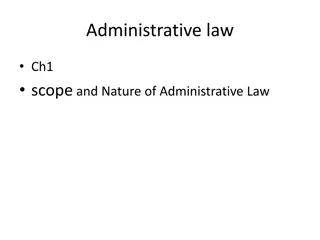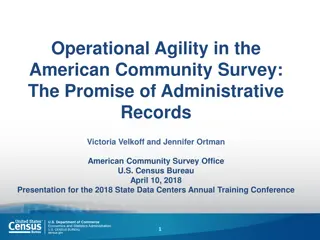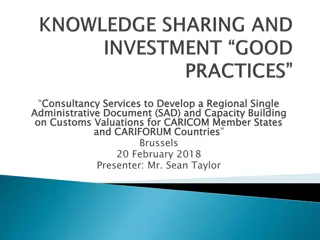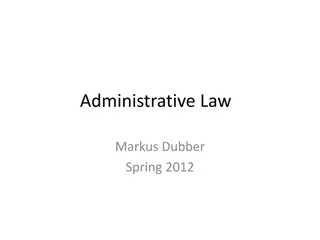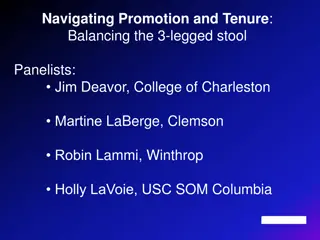Administrative Details and Panelists Information
Attendees are in listen-only mode. Explore insights on buying/selling insurance agencies, due diligence, market value appraisal, tax considerations, and Errors and Omission carrier advice from expert panelists Dirk Nohre, Matt Davis, Bob Skow, and Jim Redeker.
Download Presentation

Please find below an Image/Link to download the presentation.
The content on the website is provided AS IS for your information and personal use only. It may not be sold, licensed, or shared on other websites without obtaining consent from the author.If you encounter any issues during the download, it is possible that the publisher has removed the file from their server.
You are allowed to download the files provided on this website for personal or commercial use, subject to the condition that they are used lawfully. All files are the property of their respective owners.
The content on the website is provided AS IS for your information and personal use only. It may not be sold, licensed, or shared on other websites without obtaining consent from the author.
E N D
Presentation Transcript
Administrative Details Attendees are in listen only mode. Questions? Please use the Gotowebinar questions feature in the upper right and we will do our best to respond. For panelist questions after the webinar: Bob Skow-Bob.Skow@iiaiowa.org Dirk Nohre- dirk@nohre.com Matt Davis- Matthew_Davis@swissre.com Jim Redeker- James_Redeker@swissre.com Annette Ardler- Annette_Ardler@swissre.com No CE or loss control credit for listening to today s discussion. The slides and audio will be available on E&O Happens soon.
Our Panelists: Dirk S. Nohre- CPA, CPCU, ABV- Dirk is the senior partner at Nohre & Co., CPA s, a certified public accounting and consulting firm founded in 1992 and based in Eau Claire, WI. Dirk and his team work extensively with insurance agents and brokers providing appraisals, M&A transaction advice, internal succession planning, profitability and productivity consulting, as well as income tax planning and return preparation services. He received his BSBA from the University of North Dakota, is a certified public accountant, and has earned the CPCU and Accredited in Business Valuation (ABV) designations. Matt Davis- Matthew R. Davis is a Vice President and Claims Manager at Swiss Re Corporate Solutions in Overland Park, Kansas, with 26 years of experience working in and for the insurance industry. He joined Swiss Re in 2004, where he has focused his attention on professional liability claims involving both insurance agents and lawyers throughout the United States and Canada. Matt earned a B.A. in Economics/English from the University of Kansas and a J.D. from the University of Texas. Bob Skow-CPCU, CAE- Bob started his insurance career the day after he graduated from Drake University. He worked for Employers Mutual Insurance Co., and IMT Insurance Company. He soon decided to join the agent ranks and for 13 years owned his own agency. He was selected as the Independent Insurance Agents of Iowa Young Agent of the year in 1983. Seven years later he joined the Iowa Big I where he worked for 28 years, recently retiring. Bob served in the Iowa Legislature 3 terms, and was selected as a member of the Iowa Insurance Hall of Fame in 2007. For years he has taught insurance education programs. Jim Redeker- Jim is a Vice President and Claims Manager at Swiss Re Corporate Solutions in Overland Park, Kansas With 20 years of experience working in and for the insurance industry. He joined Swiss Re in 2002, where he has focused his attention on professional liability claims involving insurance agents throughout the United States. Jim earned a Bachelor of Science in Business Administration from Emporia State University and a J.D. from Washburn University School of Law.
Buying or Selling your agency, do your due diligence Start out by executing a confidentiality agreement so you can share important information Consider having a third party help establish market value you wouldn t buy or sell a home without an appraisal Sit down with your CPA early in the process and review tax issues that may impact the sale or buying of an agency Visit with your current Errors and Omissions carrier about any issues you should know about that might impact your exposure
Do an inspection Ask to see the agency files and financial records Check out the automation system E & O loss run
Valuating an agency Annual retention on the book of business type of business Personal, Commercial, Crop, Health Insurance (niche markets?) Compatibility of the book companies similar, etc. Are you buying expirations or renewals (target accounts exposure)? Loss Ratio with carriers and is the book meeting current volume requirements - profit share earned? Competition in the area-market area and population trends (location, location, location!!) Is the agency automated and is data transferable? Staff experienced are covenants not to compete transferable will owners stay on for a period of time or leave office building (lease/buy)? Contract or Cash?
Get it in writing! The more you get spelled out the less likely you will have issues. Utilize an Attorney and a CPA who understand agency buy/sell agreements and issues.
General Overview (in order) 1. The Buyer s and Seller s long-term goals and priorities. Buyer - Seller - + strategically acquire new territory, markets, talent, obtain expense synergies and critical revenue mass, expand value proposition, build wealth, etc. - avoid dealing with organic growth problems or other management or personnel problems + retirement and quality of life planning, reduce and spread financial risk, business perpetuation and operational continuity planning, reward key employees, mentoring opportunity, etc. - avoid personnel and other management problems, belief that a large bucket of money will make me happy 2. 3. 4. The people (talent, culture, etc.). The money (structure, price, terms, etc.). The paperwork (buy/sell agreements, purchase/sale contracts, etc.). The operational execution. 5.
Transaction Types and Subject of Transaction Overview 1 1. Transaction Types a) Purchases Sales Mergers b) Entire agency, individual book of business, branch office, division, etc. 2. Subject of Transaction Purchases and Sales 1. Assets usually preferred by outside or unrelated buyers a) Buyer purchases: a) Intangible Assets (book of business, expirations, goodwill, etc.) b) Tangible Assets (furniture and equipment, etc.) b) Seller settles their own liabilities from the sale proceeds c) Seller distributes net proceeds to owners 2. Stock (of a Corp) or Units (of an LLC) usually preferred in internal succession plans, and by C-Corp sellers a) Buyer purchases: a) Ownership interest (stock or units) from current owners a) All intangible and tangible assets, plus cash, A/R, etc., as well as all liabilities, known and unknown, go with the transaction, since they are owned by or the obligation of the selling legal entity.
Transaction Types and Subject of Transaction Overview 2 3. Subject of Transaction Mergers 1. Either a) One or more parties to the merger, merge their legal entity into the surviving entity, receiving shares or units of the surviving entity in exchange for their current shares or units, or b) All parties to the merger, merge their legal entities into a newly-formed entity, receiving shares or units of the new entity in exchange for their current shares or units 2. All assets and liabilities of each party to the merger are now in the new or surviving entity 3. Most complicated transaction primarily because of shared control issues 4. Relative valuation process (i.e. the value of each merger partner in relation to one another) can be complex, especially when there are material differences in profitability, growth, quality, and risk factors 5. Adequate pre-planning and post-planning is needed to avoid post-transaction surprises and lower the risk of costly, messy divorce .
Tax and Structure Overview 1 Purchases and Sales - 1. Buyer s Perspective a) write-off purchase price for tax purposes b) no unknown liabilities assumed 2. Seller s Perspective Single-level taxation (vs) double-level taxation a) (i.e. entity level and individual level) lowest tax rates (usually capital gains (vs) ordinary income) a) b) Transaction Price Allocation Intangible Assets (book of business, insurance expirations, goodwill) a) Buyer can deduct over 15 years b) Seller receives capital gains treatment
Tax and Structure Overview 2 Asset Sales and Form of Organization 1. Seller is Pass-Through Entity a) Types a) S-Corps b) LLC s c) Partnerships d) Or no legal entity (i.e. sole-proprietor) b) gain on sale of intangible assets is generally a capital gain c) no tax is paid at entity level d) tax is paid at owner s level (generally as an individual) 2. Seller is Non-Pass-Through Entity a) Type: C-Corps b) gain on sale of intangible assets is taxed and paid at entity level, and c) when net proceeds are distributed to owners, tax is paid again at owner level
Tax and Structure Overview 3 Stock or Unit Sales and Form of Organization 1. Seller a) gain on sale of stock or units is capital gain a) May avoid state income tax for non-resident shareholder b) may exchange seller stock for buyer stock in tax deferred transaction c) may form Employee Stock Ownership Plan (ESOP) in conjunction with internal succession strategy, with ESOP as stock buyer to obtain seller tax deferral and deductible stock purchase price 2. Buyer a) no deduction to buyer of stock a) Unless Section 338(h)(10) election is made, electing asset purchase treatment for tax purposes for BOTH buyer and seller b) Or unless ESOP strategy is used b) buyer of units can receive a deduction for purchase price if Section 754 election is made
Tax and Structure Overview 4 Mergers generally no tax gain or loss, or tax deduction, recognized or allowed on mergers New Tax Bill (related to M&A) C Corp tax rate drops to 21% Estate tax exemption increased to $11.2MM per person ($22.4MM per couple) Real estate and state income tax deductions limited to $10,000 Other Installment sale treatment
Setting a Fair Price 1 1. Valuation Based on Earnings a) Base Year - trailing twelve month (ttm) b) Adjusted/Normalized/Proforma - Remove non-recurring and non- operational items of revenue and expense and owner s perks. Average fluctuating items (i.e. contingency income). c) Earnings are normally adjusted base year Earnings Before Interest, Taxes, Depreciation and Amortization or EBITDA d) Capitalize Earnings by either a) Dividing by fair rate of return (generally 12% - 20%) or b) Multiplying by fair EBIDTA multiple (generally 5 8) Valuation Based on Revenues a) 1.0 2.5x annual commission income This method tends to assume typical profitability, growth, quality and risk factors, which can be risky and inaccurate. 2.
Setting a Fair Price 2 Illustration Income Statement Commission Income Operating Profit (EBITDA) Operating (EBITDA) Profit Margin $ $ 100 25 25.0% Capitalization of Earnings Scenario A $ Scenario B $ Earnings Divided by Capitalization Rate Equals Earnings Value Value Expressed as Multiple of Commission Value Expressesd as Multiple of Earnings 25 25 12.0% 208 2.08 8.33 20.0% 125 1.25 5.00 Setting fair rate of return (capitalization rate) Evaluate the following: - Revenue growth rate - Markets - Producers and Staff - Management - Geographic territory - Customer and Business mix - Other risk factors and synergistic opportunities
Setting a Fair Price 3 Accounting Cut-Offs Direct bill commission usually cash basis Agency bill commission income usually accrual basis described as later of coverage effective date or invoice date Subsequent (post closing) cancellations, return premium audits, etc. Contingency income usually cash basis Personnel and operating expenses usually accrual basis Errors and omissions insurance tail exposure usually cost of the seller Working capital requirement at closing especially with publicly- traded and private-equity buyers
Setting a Fair Price 4 Negotiations Not a zero sum game Identify goals of the other party Mutual decision on a fair valuation method Agree to disagree on, or set aside emotional issues during the initial process Stay focused on long-term goals Establish minimum acceptable boundaries and parameters Use objective outside party to reflect on negotiations Don t agree on agency price until terms, tax structure, owner compensation and other factors are also known or negotiated Walk-away power is the greatest power
Buy/Sell Issues Provisions of Agreement 1. Addresses circumstances (triggers) of buying and selling death disability retirement quit and remain in the business quit and exit the business Price fixed formula appraisal Terms (down payment, amortization period, interest rate) adequate cash flow for debt service Option to buy or sell (vs) requirement to buy or sell (i.e. put or call) Dispute resolution or dissolution methodology 2. 3. 4. 5.
Matt Davis, Claims Manager, Vice President Swiss Re Corporate Solutions & Jim Redeker, Claims Manager, Vice President Swiss Re Corporate Solutions
Ready, fire, aim? When to get your E&O carrier involved in the purchase/sale? Wait until the ink is dry? What your underwriter can tell you What most lawyers don t know To whom should you listen: your underwriter, lawyer or accountant?
The selling agency perspective Considerations when selling a book of business You want protection in your retirement You want protection if you ve sold the business You want to cut off liability for future problems How much of a tail?
The buying agency perspective When buying a book of business, why is acquiring only the assets of an agency (or a line of business) preferable to absorbing the entire agency (from an E&O standpoint)? Because this is claims made coverage, there must be a current policy in place that will cover errors/omissions by the Old Agency Three options: continuing coverage by the selling agency, an ERP or the buying agency s policy Due diligence only goes so far Impact on current policy pricing
Learning to love the ERP Advantages of requiring an ERP (from an E&O standpoint) An offset to the purchase price or at least, a known expense for one side or the other to absorb No impact on the Buying Agency s loss history (at least not automatically) The selling agency is not dependent on the buying agency to protect it Address payment of deductible under the ERP
Whats in a name? Why & how is the Selling Agency listed on the Buying agency s policy? DBA with a side of retro What s intended: the business continuity imperative What s not intended: free insurance for the selling agency Instead, you and your E&O carrier are recognizing that: No coverage for errors/omissions prior to the retro date There iscover for Buying Agency d/b/a Selling Agency after the retro date
Whos on first? Typical claim scenario: An allegederror on the account of Customer X happens on the watch of the selling agency The assets of the agency are sold to the buying agency including the account of Customer X on January 1, 2018 The account goes through renewal on July 1, 2018 On August 1, an un(der)covered loss occurs So which agency/E&O policy will respond? [Dramatic pause to allow local discussion]
Answer: everybody Typical lawsuit scenario: Plaintiff lawyers are unsure who is at fault, so the best approach is to sue everybody The duty of the buying agency to review the account Pain point: we often have to hire one attorney for the selling agency, a second for the buying agency and a third for the responsible party (usually the producer)
The tragedy of divorce If you think divorcing your spouse is complicated, try divorcing an insurance agency Your dying wishes are difficult to discern when there s no succession plan
E&O Takeaways Ready, aim, then fire consult with your experts first Learn to love the ERP Old errors on the selling agency, new errors on the buying agency It s as important to sell to a good agency as it is to buy from a good agency Beware the blind owner/producer Nothing beats a fresh set of eyes when you re reviewing a new account for old mistakes Merger divorce is messy. So is dying without a plan to dispose of your agency. You must anticipatethose situations
Related Resources: 1. Is Bigger Always Better?- Barbara Rocco 2. Mergers & Acquisitions Checklist 3.Buying, Selling and Merging an Agency- What should you do? Ronald Kettner & Richard Lund 4. 2017 Best Practices Study Update- www.independentagent.com/bestpractices
Panelist Contact Information: Bob Skow-Bob.Skow@iiaiowa.org Dirk Nohre- dirk@nohre.com Matt Davis- Matthew_Davis@swissre.com Jim Redeker- James_Redeker@swissre.com Annette Ardler-Annette_Ardler@swissre.com



